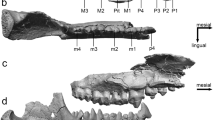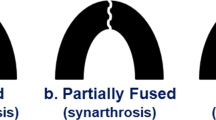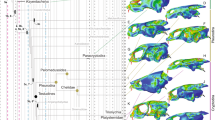Abstract
Over the past two centuries, mammalian chewing and related anatomical features have been among the most discussed of all vertebrate evolutionary innovations1,2,3. Chief among these features are two characters: the dentary-only mandible, and the tribosphenic molar with its triangulated upper cusps and lower talonid basin3,4,5. The flexible mandibular joint and the unfused symphysis of ancestral mammals—in combination with transformations of the adductor musculature and palate—are thought to have permitted greater mobility of each lower jaw, or hemimandible6,7. Following the appearance of precise dental occlusion near the origin of the mammalian crown8,9, therians evolved a tribosphenic molar with a craggy topography that is presumed to have been used to catch, cut and crush food. Here we describe the ancestral tribosphenic therian chewing stroke, as conserved in the short-tailed opossum Monodelphis domestica: it is a simple symmetrical sequence of lower tooth-row eversion and inversion during jaw opening and closing, respectively, enacted by hemimandibular long-axis rotation. This sequence is coupled with an eversion–inversion rotational grinding stroke. We infer that the ancestral therian chewing stroke relied heavily on long-axis rotation, including symmetrical eversion and inversion (inherited from the first mammaliaforms) as well as a mortar-and-pestle rotational grinding stroke that was inherited from stem therians along with the tribosphenic molar. The yaw-dominated masticatory cycle of primates, ungulates and other bunodont therians is derived; it is necessitated by a secondarily fused jaw symphysis, and permitted by the reduction of high, interlocking cusps10,11,12. The development of an efficient masticatory system—culminating in the tribosphenic apparatus—allowed early mammals to begin the process of digestion by shearing and crushing food into small boli instead of swallowing larger pieces in the reptilian manner, which necessitates a long, slow and wholly chemical breakdown. The vast diversity of mammalian teeth has emerged from the basic tribosphenic groundplan13.
This is a preview of subscription content, access via your institution
Access options
Access Nature and 54 other Nature Portfolio journals
Get Nature+, our best-value online-access subscription
$29.99 / 30 days
cancel any time
Subscribe to this journal
Receive 51 print issues and online access
$199.00 per year
only $3.90 per issue
Buy this article
- Purchase on SpringerLink
- Instant access to full article PDF
Prices may be subject to local taxes which are calculated during checkout




Similar content being viewed by others
Data availability
The raw X-ray and computed-tomography data from the opossums have been deposited in the XMAPortal (http://xmaportal.org/webportal/, with study identifier HARVARD1). Source Data for Figs. 2, 3 and Extended Data Figs. 6–9 are provided with the paper. All other data that support the findings of this study are available from the corresponding author on request.
References
Hunter, J. The Natural History of the Human Teeth: Explaining Their Structure, Use, Formation, Growth, and Diseases (J. Johnson, London, 1778).
Owen, R. On the Anatomy of Vertebrates, Vol. II. Birds and Mammals (Longmans, Green and Co., London, 1866).
Crompton, A. W. The origin of the tribosphenic molar. In Early Mammals: 2. Symposium Arranged by the Linnean Soc. (ed. Kermack, D. M.) 65–87 (Linnean Society of London, London, 1971).
Crompton, A. W. & Hylander, W. L. in The Ecology and Biology of Mammal-like Reptiles (ed. Hotton, N.) 263–282 (Smithsonian Institution Press, Washington DC, 1986).
Crompton, A. W. & Hiiemäe, K. Functional occlusion in tribosphenic molars. Nature 222, 678–679 (1969).
Crompton, A. W. & Parker, P. Evolution of the mammalian masticatory apparatus. Am. Sci. 66, 192–201 (1978).
Oron, U. & Crompton, A. W. A cineradiographic and electromyographic study of mastication in Tenrec ecaudatus. J. Morphol. 185, 155–182 (1985).
Jenkins, F. A. Jr, Crompton, A. W. & Downs, W. R. Mesozoic mammals from Arizona: new evidence on mammalian evolution. Science 222, 1233–1235 (1983).
Crompton, A. W. & Jenkins, F. A. Jr. Molar occlusion in Late Triassic mammals. Biol. Rev. Camb. Philos. Soc. 43, 427–458 (1968).
Lieberman, D. E. & Crompton, A. W. Why fuse the mandibular symphysis? A comparative analysis. Am. J. Phys. Anthropol. 112, 517–540 (2000).
Beecher, R. M. Function and fusion at the mandibular symphysis. Am. J. Phys. Anthropol. 47, 325–335 (1977).
Hylander, W. L., Johnson, K. R. & Crompton, A. W. Loading patterns and jaw movements during mastication in Macaca fascicularis: a bone-strain, electromyographic, and cineradiographic analysis. Am. J. Phys. Anthropol. 72, 287–314 (1987).
Wible, J. R., Rougier, G. W., Novacek, M. J. & Asher, R. J. The eutherian mammal Maelestes gobiensis from the Late Cretaceous of Mongolia and the phylogeny of Cretaceous Eutheria. Bull. Am. Mus. Nat. Hist. 122, 1–124 (2009).
Beiriger, A. & Sears, K. E. Cellular basis of differential limb growth in postnatal gray short-tailed opossums (Monodelphis domestica). J. Exp. Zool. B 322, 221–229 (2014).
Crompton, A. W. & Hiiemae, K. M. Molar occlusion and mandibular movements during occlusion in the American opossum, Didelphis marsupalis. Zool. J. Linn. Soc. 49, 21–47 (1970).
Menegaz, R. A., Baier, D. B., Metzger, K. A., Herring, S. W. & Brainerd, E. L. XROMM analysis of tooth occlusion and temporomandibular joint kinematics during feeding in juvenile miniature pigs. J. Exp. Biol. 218, 2573–2584 (2015).
Vandebroek, G. Origin of the cusps and crests of the tribosphenic molar. J. Dent. Res. 46, 796–804 (1967).
Hiiemae, K. & Crompton, A. W. in Functional Vertebrate Morphology (eds Bramble, D. M. et. al) 262–290 (Harvard Univ. Press, Cambridge, 1985).
Mills, J. R. E. A comparison of lateral jaw movements in some mammals from wear facets on the teeth. Arch. Oral Biol. 12, 645–661 (1967).
Brainerd, E. L. et al. X-ray reconstruction of moving morphology (XROMM): precision, accuracy and applications in comparative biomechanics research. J. Exp. Zool. A 313, 262–279 (2010).
Orsbon, C. P., Gidmark, N. J. & Ross, C. F. Dynamic musculoskeletal functional morphology: integrating diceCT and XROMM. Anat. Rec. (Hoboken) 301, 378–406 (2018).
Sánchez-Villagra, M. R. & Smith, K. K. Diversity and evolution of the marsupial mandibular angular process. J. Mamm. Evol. 4, 119–144 (1997).
Wible, J. R. On the cranial osteology of the short-tailed opossum Monodelphis brevicaudata (Didelphidae, Marsupialia). Ann. Carnegie Mus. 72, 137–202 (2003).
Luo, Z. X., Ji, Q., Wible, J. R. & Yuan, C. X. An Early Cretaceous tribosphenic mammal and metatherian evolution. Science 302, 1934–1940 (2003).
O’Leary, M. A. et al. The placental mammal ancestor and the post-K–Pg radiation of placentals. Science 339, 662–667 (2013).
Luo, Z. X., Yuan, C. X., Meng, Q. J. & Ji, Q. A Jurassic eutherian mammal and divergence of marsupials and placentals. Nature 476, 442–445 (2011).
Gatesy, J. & Springer, M. S. Phylogenomic red flags: homology errors and zombie lineages in the evolutionary diversification of placental mammals. Proc. Natl Acad. Sci. USA 114, E9431–E9432 (2017).
Grossnickle, D. M. The evolutionary origin of jaw yaw in mammals. Sci. Rep. 7, 45094 (2017).
Rowe, T. B. Osteological Diagnosis of Mammalia, L.1758, and its Relationship to Extinct Synapsida. PhD thesis, Univ. of California, Berkeley (1986).
Rowe, T. Definition, diagnosis, and origin of Mammalia. J. Vertebr. Paleontol. 8, 241–264 (1988).
Rowe, T. Coevolution of the mammalian middle ear and neocortex. Science 273, 651–654 (1996).
Murray, P. F. A unique jaw mechanism in the echidna, Tachyglossus aculeatus (Monotremata). Aust. J. Zool. 29, 1–5 (1981).
Luo, Z. X., Cifelli, R. L. & Kielan-Jaworowska, Z. Dual origin of tribosphenic mammals. Nature 409, 53–57 (2001).
Knörlein, B. J., Baier, D. B., Gatesy, S. M., Laurence-Chasen, J. D. & Brainerd, E. L. Validation of XMALab software for marker-based XROMM. J. Exp. Biol. 219, 3701–3711 (2016).
Acknowledgements
We thank A. Biewener, P. Ramirez and the remaining staff at the Concord Field Station, Harvard University, for their support; S. Gatesy for invaluable advice and assistance with Maya; G. Wagner, J. Maziarz and the rest of the Wagner Laboratory for arranging transfer of the study subjects; K. Zyskowski for assistance in preparing and accessioning specimens; and D. B. Baier for developing the XROMM Maya tools. B.-A.S.B. and J.A.M. were supported by Yale University and the Yale Peabody Museum of Natural History. A.R.M. and E.L.B. were supported by Brown University, by an NSF Graduate Research Fellowship awarded to A.R.M. and by NSF grants 1661129 and 1655756 to E.L.B. E.A.H. was supported by The University of Texas at Austin and by an NSF Graduate Research Fellowship. C.M. and A.W.C. were supported by the Harvard Museum of Comparative Zoology.
Reviewer information
Nature thanks Anthony Herrel and the other anonymous reviewer(s) for their contribution to the peer review of this work.
Author information
Authors and Affiliations
Contributions
B.-A.S.B. and A.W.C. conceived and directed the study. J.A.M. performed surgeries with assistance from C.M., A.W.C. and B.-A.S.B. C.M., A.W.C., E.L.B., J.A.M. and B.-A.S.B. recorded trials and performed computed-tomography scans. E.A.H. and B.-A.S.B. segmented and interpreted skeletal and muscular computed tomography data. A.R.M., C.M., B.-A.S.B. and E.L.B. processed videos and generated XROMM data. A.R.M. and B.-A.S.B. prepared figures, and B.-A.S.B. performed morphometric analyses. B.-A.S.B., A.R.M. and E.A.H. wrote the paper.
Corresponding author
Ethics declarations
Competing interests
The authors declare no competing interests.
Additional information
Publisher’s note: Springer Nature remains neutral with regard to jurisdictional claims in published maps and institutional affiliations.
Extended data figures and tables
Extended Data Fig. 1 Geometric morphometric analysis of mammaliaform mandibles, showing the results of principal component analysis of dentary shape.
Landmarks on Monodelphis dentary, redrawn and modified after ref. 23, are shown in the lower left. The darker red polygon encompasses all stem mammals in the analysis; the lighter red polygon encompasses all Mesozoic mammals and includes all stem therians, stem placentals and stem marsupials. The jaw of M. domestica is notably conservative, and falls near the middle of the restricted stem mammal shape-space and the larger stem therian–early therian shape-space. The M. domestica jaw is immediately surrounded by the jaws three taxa that are generally considered to be close in form to the mammalian ancestor: Morganucodon, Docodon and Hadrocodium. The ‘Mesozoic pan-therians’ includes three late-surviving early Cenozoic stem taxa (Necrolestes, Pucadelphys and Leptictis) with ghost lineages that stretch into the Mesozoic; the vertices of the light pink polygon, however, are all confirmed Mesozoic taxa.
Extended Data Fig. 2 Phylogenetic framework for geometric morphometric analysis of mammaliaform mandibles.
a, Phylogeny, including reconstructed ancestral nodes, superimposed on results from the principal component analysis shown in Extended Data Fig. 1. b, Topology used in the analysis, with relationships following previous work25,28,33. c, Enlarged depiction of landmark positions from Extended Data Fig. 1 upon the Monodelphis jaw, redrawn and modified after ref. 23.
Extended Data Fig. 3 Condylar regions of mammaliaform dentaries.
The dentary condyle of Monodelphis is conservative in its orientation, relative size and overall form.
Extended Data Fig. 4 Typical chewing sequence, shown in anterolateral view.
Muscle fibre colours correspond to those in Fig. 1.
Extended Data Fig. 5 Marker sites and details of occlusal kinematics.
a, b, Marker implantation sites for individual 1 (a) and individual 2 (b). Crania in ventral view and hemimandibles in lateral view. c, Anatomical coordinate system for the cranium, depicted in ventral and ventrolateral views on the left glenoid fossa of individual 1. d, Anatomical coordinate system for the hemimandibles, depicted in dorsal and posteromedial views on the left mandibular condyle of individual 1. e, Path of the lower first molar relative to a fixed upper molar; colouring conventions match those in Fig. 3. f, Mediolateral distance traversed by the protocone during a power stroke, indicated by red arrows and displayed on the lower first molar of individual 1.
Extended Data Fig. 6 Temporomandibular joint rotations during five additional trials from two opossums.
a, Individual 1 eating kibble. b, Individual 2 eating kibble. c, Individual 2 eating wax worms. d, Individual 2 eating wax worms. e, Individual 2 eating wax worms. Titles of the plots match trial names at http://xmaportal.org/webportal/.
Extended Data Fig. 7 Left (working side) and right (balancing side) temporomandibular joint rotations and translations for a chewing sequence of individual 1 eating wax worms.
Representative of six total trials from two opossums. See ‘Description of temporomandibular joint translations’ in the Supplementary Information. Title of the plots matches trial name at http://xmaportal.org/webportal/.
Extended Data Fig. 8 Distance between radiopaque markers in lower canines during six trials from two opossums, demonstrating the mobility of the mandibular symphysis.
a, Individual 1 eating kibble. b, Individual 1 eating wax worms. c, Individual 2 eating kibble. d, Individual 2 eating wax worms. e, Individual 2 eating wax worms. f, Individual 2 eating wax worms. Titles of plots match trial names at http://xmaportal.org/webportal/.
Extended Data Fig. 9 Left (working side) temporomandibular joint rotations and mean muscle lengths.
Euclidean distance between muscle attachment sites as determined on the basis of contrast-enhanced computed-tomography scans (means taken for all fibres modelled per muscle), for a sequence of individual 1 eating wax worms. Representative of two trials from one opossum; muscle fibres were not reconstructed for individual 2. Muscle colours correspond to those in Figs. 1–3. Title of the plots matches trial name at http://xmaportal.org/webportal/.
Supplementary information
Supplementary Information
Supplementary information (methods, calculations, Supplementary Table 1, and references). Contains detailed information regarding methods, additional data and calculations regarding variation among trials, and extended description of motions at the temporomandibular joint (TMJ).
Video 1
Chewing sequence, lateral view. Slowed 10x. Muscle fiber colours correspond to those in Fig. 1.
Video 2
Chewing sequence, posteroventral view. Slowed 10x. Muscle fiber colours correspond to those in Fig. 1.
Video 3
Dorsal view of the cranium throughout a chewing sequence, highlighting the attachments of the superficial masseter (cyan) and medial pterygoid (light green). Slowed 10x. See also Fig. 4.
Video 4
Medial view of left first molar pair throughout a chewing sequence. Slowed 10x.
Video 5
Posteromedial view of the left molars throughout a chewing sequence, highlighting the paths of protocones. Slowed 10x. Colouring conventions match those in Fig. 4b-c.
Video 6
Posterior view of the left first molar pair throughout a chewing sequence, highlighting the path of the lower molar relative to a fixed upper molar. Slowed 10x. Colouring conventions match those in Fig. 4b-d and 5a-b.
Rights and permissions
About this article
Cite this article
Bhullar, BA.S., Manafzadeh, A.R., Miyamae, J.A. et al. Rolling of the jaw is essential for mammalian chewing and tribosphenic molar function. Nature 566, 528–532 (2019). https://doi.org/10.1038/s41586-019-0940-x
Received:
Accepted:
Published:
Issue Date:
DOI: https://doi.org/10.1038/s41586-019-0940-x
This article is cited by
-
Articular surface interactions distinguish dinosaurian locomotor joint poses
Nature Communications (2024)
-
Derived faunivores are the forerunners of major synapsid radiations
Nature Ecology & Evolution (2023)
-
Functional reorganisation of the cranial skeleton during the cynodont–mammaliaform transition
Communications Biology (2023)
-
Jaw roll and jaw yaw in early mammals
Nature (2020)
-
Molar occlusion and jaw roll in early crown mammals
Scientific Reports (2020)
Comments
By submitting a comment you agree to abide by our Terms and Community Guidelines. If you find something abusive or that does not comply with our terms or guidelines please flag it as inappropriate.



